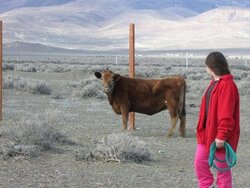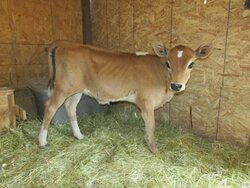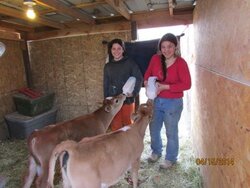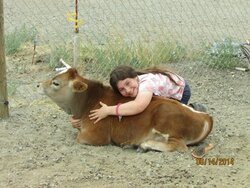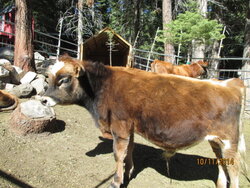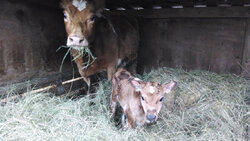Like to see the new Bull Calf?
- Thread starter valley ranch
- Start date
-
Active since 1995, Hearth.com is THE place on the internet for free information and advice about wood stoves, pellet stoves and other energy saving equipment.
We strive to provide opinions, articles, discussions and history related to Hearth Products and in a more general sense, energy issues.
We promote the EFFICIENT, RESPONSIBLE, CLEAN and SAFE use of all fuels, whether renewable or fossil.
You are using an out of date browser. It may not display this or other websites correctly.
You should upgrade or use an alternative browser.
You should upgrade or use an alternative browser.
- Status
- Not open for further replies.
eclecticcottage
Minister of Fire
Close but, he's a Jersey
Hey, I guessed right! It's in the eyes...my fav breed. He's quite a looker.
Close but, he's a Jersey, comes from a good family all registered. We went out of state to get him. He' 3 weeks old, still on a bottle, getting stronger every day.
Looks like Jersey milk might be better for you too.
http://www.motherjones.com/environment/2014/03/a1-milk-a2-milk-america
Looks like Jersey milk might be better for you too.
http://www.motherjones.com/environment/2014/03/a1-milk-a2-milk-america
We actually have them tested for A1 A2. It makes a difference when you sell them. Pasteurized milk is thought also to be a problem yet Raw Milk can't be sold in some states.
This heifer is first in line for the young fellow, she doesn't see much in him right now, but in about 6months she'll change her tune.
Richard
Attachments
History of the Magnificent Jersey Breed
A Brief History of the Jersey Cow
The Channel Islands are located at the northwest coast of France and the south coast of England. The cattle which are located there still today, have been there for thousands of years, with the exception of the Alderney cattle. During WWII, most of the pure-breed Alderney cattle were removed from the island of its name, to Guernsey in the summer of 1940, because the island was then occupied by the Germans and it was difficult for the few remaining islanders to milk them. On Guernsey, the cattle were interbred with local breeds. The few pure-breed cattle remaining on Alderney were killed and eaten by the Germans in 1944. 1 At an undetermined future time, the Alderney cow was migrated to the Isle of Jersey and became estabished as the predominate dairy cow on that island, eventually being exported from there throughout the world. The breed name was then established as "Jersey", forgoing it's former historical beginning.
Up until this time, the Channel Islands of Alderney, Jersey and Guernsey, produced some wonderful dairy breeds of cattle. It was the Alderney cattle who were “deer like” in conformation with wide bulging eyes and fine boning. These special traits are what we now admire in the Jersey cow as referred to by Willis P. Hazard in 1872, below:
The animal known in England and elsewhere under the name of the Alderney cow, is the same which is now under our consideration. The reason for the breed going under the name of Alderney is, that from that island the first were exported to England. In form, the Jersey cow is deer-like, and small in size; the colors mostly prized are the light red and white, the brown and the fawn; brindled specimens are rarely seen; they are not at all valued, and may be purchased extremely cheap. The cow is naturally quiet, so much so that a mere child can manage her. She had always possessed the head of a fawn, a soft eye, an elegant crumpled horn, small ears, yellow within, a clean neck and throat, fine bones, a fine tail; above all, a well formed, capacious udder, with large, swelling milk veins. 2
In 1789, the Jersey breed was already considered to be far superior to any known dairy cow in production. Her milk was rich and plentiful while her cream was unsurpassed in butterfat. The local legislature passed a law that banned importation of any other horned bull, cow, calf or heifer to the island under stiff penalty. And if caught doing so, the animals being brought in, were to be killed immediately with the meat given to the poor. Thus, the law remains to this day…no foreign horned cattle are allowed to come to Jersey with the exception of butcher’s meat. Guernsey cattle were not deemed foreign, but there were relatively few of them present on the island of Jersey
There were also distinct differences between the cattle from one side of the island (Jersey) to the other. The north/northwest coast of Jersey is high and rocky with short, lush vegetation. Thus, the cattle from this side of the island were small and very fine boned, yet very hardy. On the southward facing part of the island, the terrain was very lush in pasture, sloping gracefully to the sea coast. The cattle here grew much larger and were considered to be more delicate. It was then advised to never out cross this breed, but instead to cross the smaller cattle of the higher mountainous region with those of the lower region. These larger mid-sized cows seem to be the most profitable and desired cattle of this breed. But, the smaller cows can get by with less forage and seem somewhat hardier than their mid-sized counterparts. They can also be kept in smaller acreage, thus, more cattle can be maintained to produce more calves to sell.
“A large Ayrshire or Dutch cow, giving 4000 quarts of milk during the year, will produce an over-supply during one season, and go entirely dry at another. She will consume as much food as would support two little Jerseys giving each 2000 quarts of milk, one coming in in the spring and one coming in in the fall. In perhaps a majority of instances, accommodation can be furnished for only one cow, and food for only one small one. For such cases the smaller Jerseys are especially adapted, such as will give ten quarts of milk at their flush(freshening), and not fall below three quarts within six weeks of the next calving; the cream increasing in proportion and becoming richer as the quantity of milk decreases, thus maintaining a satisfactory quantity for at least ten months of the year, and yielding enough for necessary use during the eleventh.” 3
The Jersey breed is known for its richness of cream and volumes of it. It is also thought that when the cows are forced to produce larger quantities of milk, it gets thinner with a smaller cream band. The Jersey carcass as beef, has a yellow fat and should not be hanged for aging longer than 7 days to prevent the fats from turning rancid. This is because the Jersey is not known to digest the beta carotene from its food. That stored beta carotene is the reason for the rich yellow color of the milk, cream and carcass fat.
During the late 1800’s, the exportation of the original Jerseys were high in demand into the USA and around the world, butonly in the taller sizes. So, many of the original smaller animals were hunted down and killed to keep them from breeding more of the smaller cattle, which did not sell well at that time. The mid-sized cattle were considered to be the “perfect milk cow” because of her size not too big for the smaller homestead farm nor too small to produce enough to feed the family with ease.
Today, the Alderney cattle are extinct on that island with only the crossed bloodlines still remaining in the Jersey’s and Guernsey’s of today.
A Brief History of the Jersey Cow
The Channel Islands are located at the northwest coast of France and the south coast of England. The cattle which are located there still today, have been there for thousands of years, with the exception of the Alderney cattle. During WWII, most of the pure-breed Alderney cattle were removed from the island of its name, to Guernsey in the summer of 1940, because the island was then occupied by the Germans and it was difficult for the few remaining islanders to milk them. On Guernsey, the cattle were interbred with local breeds. The few pure-breed cattle remaining on Alderney were killed and eaten by the Germans in 1944. 1 At an undetermined future time, the Alderney cow was migrated to the Isle of Jersey and became estabished as the predominate dairy cow on that island, eventually being exported from there throughout the world. The breed name was then established as "Jersey", forgoing it's former historical beginning.
Up until this time, the Channel Islands of Alderney, Jersey and Guernsey, produced some wonderful dairy breeds of cattle. It was the Alderney cattle who were “deer like” in conformation with wide bulging eyes and fine boning. These special traits are what we now admire in the Jersey cow as referred to by Willis P. Hazard in 1872, below:
The animal known in England and elsewhere under the name of the Alderney cow, is the same which is now under our consideration. The reason for the breed going under the name of Alderney is, that from that island the first were exported to England. In form, the Jersey cow is deer-like, and small in size; the colors mostly prized are the light red and white, the brown and the fawn; brindled specimens are rarely seen; they are not at all valued, and may be purchased extremely cheap. The cow is naturally quiet, so much so that a mere child can manage her. She had always possessed the head of a fawn, a soft eye, an elegant crumpled horn, small ears, yellow within, a clean neck and throat, fine bones, a fine tail; above all, a well formed, capacious udder, with large, swelling milk veins. 2
In 1789, the Jersey breed was already considered to be far superior to any known dairy cow in production. Her milk was rich and plentiful while her cream was unsurpassed in butterfat. The local legislature passed a law that banned importation of any other horned bull, cow, calf or heifer to the island under stiff penalty. And if caught doing so, the animals being brought in, were to be killed immediately with the meat given to the poor. Thus, the law remains to this day…no foreign horned cattle are allowed to come to Jersey with the exception of butcher’s meat. Guernsey cattle were not deemed foreign, but there were relatively few of them present on the island of Jersey
There were also distinct differences between the cattle from one side of the island (Jersey) to the other. The north/northwest coast of Jersey is high and rocky with short, lush vegetation. Thus, the cattle from this side of the island were small and very fine boned, yet very hardy. On the southward facing part of the island, the terrain was very lush in pasture, sloping gracefully to the sea coast. The cattle here grew much larger and were considered to be more delicate. It was then advised to never out cross this breed, but instead to cross the smaller cattle of the higher mountainous region with those of the lower region. These larger mid-sized cows seem to be the most profitable and desired cattle of this breed. But, the smaller cows can get by with less forage and seem somewhat hardier than their mid-sized counterparts. They can also be kept in smaller acreage, thus, more cattle can be maintained to produce more calves to sell.
“A large Ayrshire or Dutch cow, giving 4000 quarts of milk during the year, will produce an over-supply during one season, and go entirely dry at another. She will consume as much food as would support two little Jerseys giving each 2000 quarts of milk, one coming in in the spring and one coming in in the fall. In perhaps a majority of instances, accommodation can be furnished for only one cow, and food for only one small one. For such cases the smaller Jerseys are especially adapted, such as will give ten quarts of milk at their flush(freshening), and not fall below three quarts within six weeks of the next calving; the cream increasing in proportion and becoming richer as the quantity of milk decreases, thus maintaining a satisfactory quantity for at least ten months of the year, and yielding enough for necessary use during the eleventh.” 3
The Jersey breed is known for its richness of cream and volumes of it. It is also thought that when the cows are forced to produce larger quantities of milk, it gets thinner with a smaller cream band. The Jersey carcass as beef, has a yellow fat and should not be hanged for aging longer than 7 days to prevent the fats from turning rancid. This is because the Jersey is not known to digest the beta carotene from its food. That stored beta carotene is the reason for the rich yellow color of the milk, cream and carcass fat.
During the late 1800’s, the exportation of the original Jerseys were high in demand into the USA and around the world, butonly in the taller sizes. So, many of the original smaller animals were hunted down and killed to keep them from breeding more of the smaller cattle, which did not sell well at that time. The mid-sized cattle were considered to be the “perfect milk cow” because of her size not too big for the smaller homestead farm nor too small to produce enough to feed the family with ease.
Today, the Alderney cattle are extinct on that island with only the crossed bloodlines still remaining in the Jersey’s and Guernsey’s of today.
Dix
Minister of Fire
flyingcow
Minister of Fire
Jerseys are a great laid back milks cow. The production is not near as good as a Holestien.I deal with Jerseys out at the museum.
They are sweet hearts !
flyingcow
Minister of Fire
depends, but both breeds have a lot to offer. I've seen Holsteins give pretty high components. Both will give excellent quality, if the farmer is doing everything right. Quality is all in the environment that is provided for them.
Seems genetic too. Holsteins appear to be high A1 protein sources according to the article. Jerseys are A2.depends, but both breeds have a lot to offer. I've seen Holsteins give pretty high components. Both will give excellent quality, if the farmer is doing everything right. Quality is all in the environment that is provided for them.
Lake Girl
Moderator
Good luck with the new herd ... My kids got to see some of the calving at the school bus driver's farm ... a couple of times he made a quick stop at his house to check on progress before completing the run to school. Beef cows around here - mostly Herefords.
Dairy cows that I've seen more often are Holsteins...
Dairy cows that I've seen more often are Holsteins...
1kzwoman
Minister of Fire
The Jersey cow we had as a kid put a quart of cream on a gallon of milk. Talk about whole milk, we stirred it in for our house. Skimmed half off milk we sold to make our butter, cottage cheese and ice cream. A dairy bull spends most of his time away from cows in a dairy herd, most have a nasty outlook Holstein comes to mind as best to avoid.
Maybe cause they don't all get lap time ! Handsome lad!
Maybe cause they don't all get lap time ! Handsome lad!
1kzwoman
Minister of Fire
Beef ala carte?
I bet not! He's intact mini Jersey... I Think he will advance the genetics of the breed in another year. Sold outside herd or in a new one at home
I bet not! He's intact mini Jersey... I Think he will advance the genetics of the breed in another year. Sold outside herd or in a new one at home
You know mini's.
We found this young lady in Oregon. She, the calf, is now: Silver Lake Ranch's Bluebell Bella.
Attachments
1kzwoman
Minister of Fire
You know mini's.
We found this young lady in Oregon. She, the calf, is now: Silver Lake Ranch's Bluebell Bella.
Nope but Hereford cattle raised for breeding stock for others... Bull were sold heifers replaced aging cows and we ran two unrelated bloodlines/ herds.
She is a beautiful Jersey heifer!
- Status
- Not open for further replies.
Similar threads
- Replies
- 2
- Views
- 198
- Replies
- 3
- Views
- 271
- Replies
- 8
- Views
- 864


